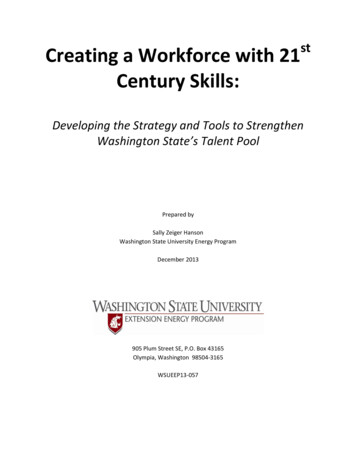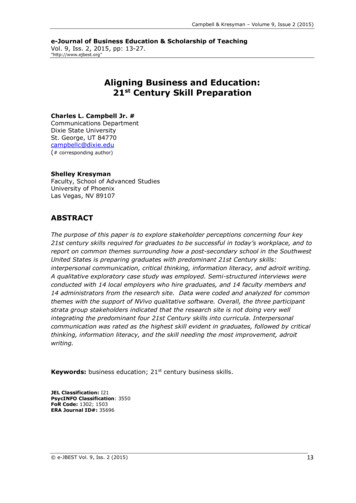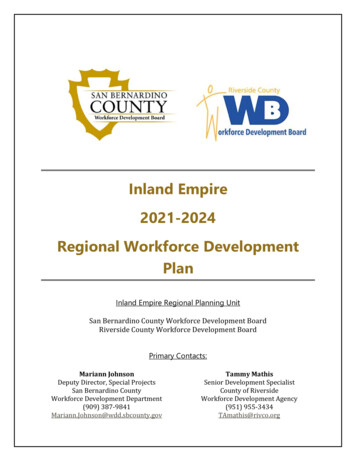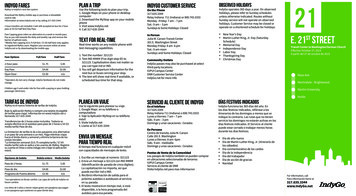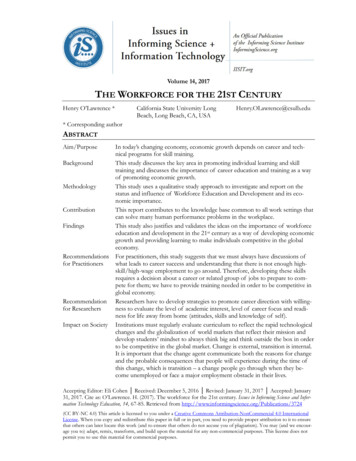
Transcription
Volume 14, 2017THE WORKFORCE FOR THE 21ST CENTURYHenry O’Lawrence *California State University LongBeach, Long Beach, CA, USAHenry.OLawrence@csulb.edu* Corresponding authorABSTRACTAim/PurposeIn today’s changing economy, economic growth depends on career and technical programs for skill training.BackgroundThis study discusses the key area in promoting individual learning and skilltraining and discusses the importance of career education and training as a wayof promoting economic growth.MethodologyThis study uses a qualitative study approach to investigate and report on thestatus and influence of Workforce Education and Development and its economic importance.ContributionThis report contributes to the knowledge base common to all work settings thatcan solve many human performance problems in the workplace.FindingsThis study also justifies and validates the ideas on the importance of workforceeducation and development in the 21st century as a way of developing economicgrowth and providing learning to make individuals competitive in the globaleconomy.Recommendations For practitioners, this study suggests that we must always have discussions offor Practitionerswhat leads to career success and understanding that there is not enough highskill/high-wage employment to go around. Therefore, developing these skillsrequires a decision about a career or related group of jobs to prepare to compete for them; we have to provide training needed in order to be competitive inglobal economy.Recommendation Researchers have to develop strategies to promote career direction with willingfor Researchersness to evaluate the level of academic interest, level of career focus and readiness for life away from home (attitudes, skills and knowledge of self).Impact on Society Institutions must regularly evaluate curriculum to reflect the rapid technologicalchanges and the globalization of world markets that reflect their mission anddevelop students’ mindset to always think big and think outside the box in orderto be competitive in the global market. Change is external, transition is internal.It is important that the change agent communicate both the reasons for changeand the probable consequences that people will experience during the time ofthis change, which is transition – a change people go through when they become unemployed or face a major employment obstacle in their lives.Accepting Editor: Eli Cohen Received: December 5, 2016 Revised: January 31, 2017 Accepted: January31, 2017. Cite as: O’Lawrence. H. (2017). The workforce for the 21st century. Issues in Informing Science and Information Technology Education, 14, 67-85. Retrieved from CC BY-NC 4.0) This article is licensed to you under a Creative Commons Attribution-NonCommercial 4.0 InternationalLicense. When you copy and redistribute this paper in full or in part, you need to provide proper attribution to it to ensurethat others can later locate this work (and to ensure that others do not accuse you of plagiarism). You may (and we encourage you to) adapt, remix, transform, and build upon the material for any non-commercial purposes. This license does notpermit you to use this material for commercial purposes.
Workforce for the 21st CenturyFuture ResearchKeywordsNew research should focus on career assessment materials and related academicprograms and career directions that will promote success.workforce development, technology, unemployment and employment growth,labor force, education and job training, economic growth and instructionaltechnologyINTRODUCTIONWorkforce education and development is the key to promoting individual learning and skill training.Career and technical educators throughout the nation are affected by what goes on globally becauseof new developments, improved communication, faster travel, and increased commerce, which leadto global competition. What makes some nations rich, with their citizens enjoying a high standard ofliving, is commerce, that is, producing, selling, and buying goods and services that lead to jobs, individual wealth, and a high standard of living. For a nation to be competitive in a global economy, itshuman capital (workers) must be trained and educated to develop its natural resources and able toimprove productivity and technology (Gordon, 2008; Gray & Herr, 1998a; O’Lawrence, 2008b).Natural resources, technology, and human capital are important strategic economic advantages. Human capital is the most important of the three; the most important elements in the quest for a competitive advantage in commerce are the skills and initiative of a nation’s workforce. Technology isonly as good as the ingenuity of those who can both maintain and use it to its fullest potential. Thosewho have a workforce that can use the technology to the fullest will have the advantage over thosewho cannot, and those with the highest skilled labor force will be able to adopt technology faster anduse it to produce the best quality at the lowest price (Gray & Herr, 1998a; Thurow, 1992).Indicators suggest that the U.S. has the worst-educated unskilled nonprofessional/hourly workforceamong the major economic powers because of a lack of investment in workers’ training and retraining (Chao, 2006). The U.S. postsecondary education system represents the education of our workforce. Higher education has been a principal means of social mobility for many acculturating immigrants and for empowering minorities (Allen, 2002). Vocational education, increasingly known as career and technical education, is a longstanding program that continues to evolve in American education. The broadening of its goals, its participants’ widening diversity, and the changing education andlabor market climate in which it operates suggest vocational education programs are a flexible optionfor colleges and students (Silverberg, Warner, Fong, & Goodwin, 2004).This study identifies and reports on (a) major factors that influence the nation’s economy, (b) howwell the unemployment rate is controlled, (c) the labor force, (d) employment growth, and (e) howcommitted the nation is to educating the labor force. These five areas prove in the analysis that theyshould be considered seriously, as they lead to increased global competitiveness. History also tells usthat no society can long survive unless the society as a whole becomes aware that meaningful work,done well, and dedication are essential aspects of a worthwhile life. This should be made known inour classrooms and should be one of the major goals of education. It is important in the 21st centuryto reexamine and debate the importance of workforce education—corporate training and humanresources development—on our economy: globally, federally, statewide, regionally, and locally. As wecontinue to review the current status of the economy, we should be concerned with unemployment,especially why college graduates can secure only mediocre jobs or nothing at all, and why our veterans are on the streets, homeless, jobless, and unwanted (O’Lawrence, 2008b, 2016).When thinking about these issues, policymakers should consider the importance of workforce skilland retraining programs that benefit individuals seeking training for employment. As a result of theseissues, this report proposes that political leaders and educational policymakers anticipate the nation’schanging employment needs and facilitate better fits among high school graduates, college graduates,veterans returning from war, and employment opportunities. Workforce development programs allow students to acquire the special competencies associated with a particular vocation after they havelearned something about their own special aptitudes and capacities, understand the range of work68
O’Lawrencespecializations available to them, and know the requirements and rewards associated with differentoccupational pursuits.This analysis is divided into four different sections: unemployment rate, labor force, employmentgrowth, and the importance of career and technical education programs. Today’s college studentsrealize the impact of information technology on society, the global phenomenon of world of competitiveness brought about by new characteristics of mass communication, and the potential forbringing remote parts of the world to the forefront of economic development. Indeed, the world isbecoming flatter and virtually smaller every day. The influence of technology on education includesdevelopments designed to provide almost instant communication from one geographical area to another. It is a way of social life, frequently linked with communication and motivation for socialchange (Friedman, 2007). Information technology has brought rapid transmission of news, andevents create consequences that other nations consider immediately, such as creating businessindustrial mechanisms that cannot be reversed.In international relations, the art of diplomacy has been affected in various ways by the use of information technology. This has served to enhance our understanding of third-world countries andother parts of the world. The world is overwhelmingly different in this regard from what it was andthe universal tool of today—computer technology—is a global tool that has come to stay. If technology does not destroy us as a society, it will eventually make us a better society. Information technology brought educational reform to a changing society with the anticipation that education wouldbe much better than in the past. However, there is tremendous concern among both politicians andeducators that we might be heading toward the collapse of education structures if precautions arenot taken. The question remains whether technology will make us or breaks us in the global economy, help us maintain our status as a superpower, and, of course, make us competitive. What wouldbreak us is our refusal to acknowledge the importance of career technical education, skill training,and retraining of citizens (O’Lawrence, 2007).It is questionable as to why change occurs so slowly in our attitudes toward the value and necessityof vocational or occupational education, career technical education, and workforce development.Those in this field are held in the highest esteem, and their work ethic is fundamental to the valuesystem that prepares us for the meaningful work that our economy, community, and society deserve.Workforce development education trains the mind, inculcates values, and strengthens the individual’scapacity for responsible citizenship. It is important to recognize that workforce competence is theability to use one’s talents constructively toward productive ends that are economically valuable in themarketplace and is an important aspect of responsible citizenship (O’Lawrence, 2008a).Our nation’s schools’ response to changing needs and opportunities can be viewed in the context ofthree fundamental educational tasks: socialization, social mobility, and individual self-realization. Ourtask is to educate, leading to the ability to participate constructively in the global economy, engage inpolicy, and advance the social-civic life of society by using information technology to produce a flexible labor force that will react effectively to the labor market. It is important to continue to find waysto develop curricula appropriate to students with special interests and abilities so that they can succeed in workforce related competencies. It is important to continue business and government support for higher education to help colleges and universities meet the challenges of a new economy(Barrow, 2000). Barrow (2000) indicates that higher education administrators also have to agree thatcurricula need to continue to focus more on areas that are significant to economic growth: Symbolic skills (conceptual, mathematical, and visual), not only specialized disciplinary content, Research skills, rather than established expertise, and Communications skills (oral and written), rather than mere “self-expression”.The only way these can be achieved is when higher education institutions can produce a workforcethat is highly educated and trained. As capital becomes globally mobile, a solid strategy for high-wage69
Workforce for the 21st Centurydeveloped nations to attract private capital investment will be through the skills and productivity ofits domestic workforce. The 21st century workforce and higher education must be positioned to respond to the global challenge to our economy and human resources. The workforce and higher education must ensure that students identify potential occupations as soon as possible along with thetype of education and training needed for those occupations in order to be prepared and competitive. There is a need for articulation agreements among business, government, colleges, and universities to help promote and coordinate course work that will lead to real jobs and sustainable growth(Barrow, 2000; O’Lawrence, 2016).ANALYSIS AND FINDINGST HE U NEMPLOYMENT R ATE IN THE U NITED S TATESEvery two years the Bureau of Labor Statistic publishes projected U.S. economic factors that formthe basis for the employment projections program. The unemployment rate is normally reported bythe U.S. Bureau of Labor Statistics. The unemployment rate in the U.S. averaged 5.83% from 1948until 2014. The U.S. Department of Labor (2006) reported that in the first half of 2006 the unemployment rate averaged 4.7%, lower than the 5.1% average of 2005 and a full point lower than the5.7% average unemployment rate of the 1990s. A comparison of France and Germany shows thatboth countries have persistent unemployment rates nearly double that of the U.S. and their long-termunemployment of 12 months or more is nearly triple that of the U.S. More than 5.4 million net newjobs had been created in the United States since August 2003 (Chao, 2006). In addition to projectedemployment growth the recovery of the housing market, improved consumer confidence, strongbusiness investment, rising medical expenses, and narrowing of the trade deficit also characterize theoutlook of the U.S. economy in 2020.Table 1 reports the unemployment rate between 2004 and 2014Table 1: Labor Force status of Unemployment rate between 2004 and 2014for 16 years old and 6.6 6.7 6.6 6.2 6.36.1 6.2 6.1 5.95.75.8Adapted from the Labor Force Statistics from the Current Population survey(Series Id: LNS14000000)5.6Most of the new jobs projected for the future are expected to be filled by persons with postsecondary education credentials. Workers who bring to the labor market the knowledge and skills that thecompetitive economy demands are able to secure positions with rising compensation; those who donot keep up with the relevant workplace knowledge and skills increasingly lag behind in employmentand earnings. Provisions must be made by the institutions of higher learning to ensure that all stu-70
O’Lawrencedents have access to the information, training, and resources that will help them acquire the skillsthey need to access the growing employment opportunities in our nation’s 21st century economy(Chao, 2006; Gray & Herr, 1998a; O’Lawrence, 2013).The recent report from the Bureau of Labor Statistics (BLS, 2014) indicated that the economy grewat an annual rate of 4% in the second quarter of 2014; if that rate continues that would mean thatthe growth rate has now been consistent with past recovery and the unemployment rate stands at6.2% while job gains occurred in the areas such as professional and business services, manufacturing,retail trade, and construction. The GDP growth rate informs us how fast a county’s economy isgrowing. When the economy is expanding the GDP growth rate become positive, and, if it is growing, business, jobs, and personal income become positive as well. The following facts were summarized: Business investment in the second quarter of 2014 rose by 5.5% after rising a meagre 1.6%in the first quarter and making policy makers wonder if the corporations would increasespending. In the housing sector realized an increase in investment which rose by 7.5% after two quarters of decline; an indication that the housing market might be improving. The manufacturing sector expanded in July 2014 for the 14th consecutive month.In another study as recently as November 7, 2014, the jobs report included seven million Americansin part-time work because they could not find full employment; and only 35% registered voters believed that the economy was getting better despite the official employment statistics that show unemployment is at its lowest level of 5.8% since mid-2008 (Wessel, 2014).T HE L ABOR F ORCEThe U.S. is known as a leader in workforce productivity; however, what distinguishes the UnitedStates from other productivity leaders, such as France, is that the U.S. workforce is also a leader inwork effort, that is, hours on the job. Hours worked per capita is a single measure of the labor activity across the population—taking into account both the portion of the population that is employedand the number of hours’ people work. Sommers and Franklin (2012) discussed employment outlook from 2010-2020 and in their overview of projections to 2020 in the monthly labor review thatfeatures the Bureau of Labor Statistics (BLS) 2010-2020 employment projections. These projectionssuggest a slow labor force growth and a gross domestic product growth of 3.0% annually that wouldresult in a gain of 20.5 million between 2010 and 2020. Industries and occupations related tohealthcare and construction are projected to the fastest job growth.For concepts and definitions, Gross Domestic Product (GDP) is defined as the value of all marketand some nonmarket goods and services produced within a country’s geographic borders. GDP isthe most comprehensive measure of a country’s economic output that is estimated by statisticalagencies. GDP per capita may, therefore, be viewed as a rough indicator of a nation’s economic wellbeing, while GDP per hour worked can provide a general picture of a country’s productivity (Sommers & Franklin, 2012).The country with the highest GDP per capita, Norway, had a GDP per capita value in 2011 that wasmore than twice that of the country with the lowest value, the Czech Republic. In 2011, real GDPper capita grew in 18 of the 20 countries compared with the largest increases occurring in the Republic of Korea and Singapore. The GDP per hour worked is an indicator of a country’s productivity. For example, in 2011 Norway had the highest level of GDP per hour among the countries covered and approximately 20% higher than the next highest ranked country, Ireland, and roughly threetimes the level of the Republic of Korea. While Singapore had the second highest level of GDP percapita, it had a relatively low GDP per hour worked. Overall, countries with low levels of GDP perhour worked, such as Singapore and the Republic of Korea, had a high number of annual average71
Workforce for the 21st Centuryhours worked per employed person. In general, European countries had a lower number of averageannual hours worked than non-European countries, and average annual hours were lowest in Germany and Norway while the European country with the highest level of average annual hoursworked was the Czech Republic, followed by Italy (BLS, 2012c). For international comparisons oflevels of GDP, GDP per capita, or GDP per hour worked, the output has to be measured in a common currency unit. BLS converts the output measures from national currency units to U.S. dollarsthrough the use of purchasing power parities (PPPs). PPPs are currency conversion rates that allowoutput in different currency units to be expressed in a common unit of value – in this case U.S. dollars. The PPP for a given country is a ratio, where the numerator is the number of national currencyunits needed to purchase a specific basket of goods and services in that country and the denominator is the number of U.S. dollars needed to purchase a similar basket of goods in the United States,the base country (BLS, 2012c).With respect to the economic indicators previously discussed, the United States generally has ledmost other Organization for Economic Cooperation and Development (OECD) nations since 2000.The same holds true across most labor market measures, and it reflects strength throughout the U.S.labor market. At 5.1%, the U.S. unemployment rate in 2005 was well below that of most of its European peers. Both Japan and South Korea benefited from even lower rates, continuing long-termtrends for both countries. The United Kingdom’s rate has hovered around 5% for several years, aftertrending down from more than 10% in 1993 (BLS, 2012c).Among the major worker groups, unemployment rates for adult women (7.3%) and Blacks (14.0%)edged up in December, while the rates for adult men (7.2%), teenagers (23.5%), Whites (6.9%), andHispanics (9.6%) showed little or no change. The jobless rate for Asians was 6.6% (not seasonallyadjusted), which was little changed from a year earlier. In December 2012, the number of long-termunemployed (those jobless for 27 weeks or more) was essentially unchanged at 4.8 million and accounted for 39.1% of the unemployed. It was projected that the U.S. labor force will reach 163. 5million in 2020 and the growth in the labor force from 2012 -2020 was also predicted to be smallerthan in the previous 10-year period between 2002-2012 when the labor force grew by 10.1 millionresulting to about 0.7% annual growth rate (Bureau of Labor Statistics, 2013a).E MPLOYMENT GROWTHThe best route to low unemployment is strong employment growth which also accompanies economic growth. The labor markets of both the United States and the European Union are quite similar in size, which offers opportunities for comparison on measures pertinent to the discussion. Between 1990 and 2005, civilian employment in the United States rose 19.3%, while the comparablemeasure for the European Union rose 11.1%. Since 2003, the United States again has taken the lead,while a number of European countries have seen somewhat stagnant employment growth, most notably France and Germany (U.S. Department of Labor, 2008).In 2013, the national unemployment rate was at 7.3% as the jobless rate decreased from 8.1% in2012; among gender and race analysis, the unemployment rates for adult men (7.1%), adult women(6.3%), teenagers (22.7%), whites (6.4%), blacks (13.0%), and Hispanics (9.3%) had little change.The jobless rate for Asians was 5.1% (not seasonally adjusted), little changed from a year earlier (Bureau of Labor Statistics, 2013a).The Bureau of Labor Statistics (2013a) also estimated that anywhere between 300,000 and 500,000U.S. jobs have already been lost and a projected 6 million U.S. jobs will be outsourced in 2014. Recentadvancements in technology, trading commodities has becoming even more necessary for businessesacross the world. S. P. Brown and Siegel (2005) define outsourcing as the movement of work thatwas formerly conducted in-house by employees paid directly by a company to a different companywhile the different company can be located inside or outside of the United States and the work canoccur at a different geographic location or remain onsite. They also defined offshoring as the movement of work from within the United States to locations outside of the United States that can occur72
O’Lawrencewithin the same company and involve movement of work to a different location of that companyoutside of the United States or to a different company altogether.The Bureau of Labor Statistics (2015) reported that unemployment rate was essentially unchanged at5.0% with job gains occurring in professional and business services such as healthcare (added 45,000new jobs in October), retail trade (added 44,000 new jobs), food services and drinking places (added42,000 new jobs), and construction (added 31,000 new jobs). Accordingly, and as reported, the unemployment rate of 5% and the number of unemployed about 7.9 million people were essentiallyunchanged in October; and over the past 12 months, both the unemployment and the number ofunemployed people were down by only 0.7 percentage point and 1.1 million respectively. The following were also reported: The unemployment rates for adult men is 4.7%The unemployment rates for adult women is 4.5%For Teenagers 15.9%Whites 4.4%Blacks 9.2%Asians 3.5% andHispanics 6.3%In this age of globalization, companies have developed a new kind of trade, offshore outsourcing,which is the subcontracting of U.S. jobs to foreign workers. Hundreds and possibly thousands ofU.S. companies have jumped on the outsourcing bandwagon, transferring a number of U.S. jobs toworkers in foreign countries, resulting in unemployment for many American citizens. Offshore outsourcing is a growing economic trend that is costing thousands (and eventually millions) of UnitedStates workers their jobs; without federal restrictions set on private companies, Americans will continue to lose their jobs to workers in developing countries due to reduced labor costs and technological advancement that is allowing work to be completed all around the worldArguments made during the 2012–2013 presidential election indicated more jobs will be created andnew programs will be developed to allow U.S. workers who have lost their jobs to find work in otherfields. This assertion is based on past economic trends, and not on fact. How are the thousands ofU.S. workers who have already lost their jobs being impacted? Offshore outsourcing is a growingtrend, and it will continue to grow as long as competition exists. For example, the International Finance Corp., which is one of the World Bank’s investment arms, plans to sell 1 billion of rupeebonds offshore to fund its investments as India struggles to lure capital amid the slowest growth in adecade in order to attract greater foreign investment due to economic uncertainty across the world(Cao, Xie, & Rodrigues, 2013).This trend has potentially harmful effects on American job prospects. As of October 2014, sixteenpercent of Americans are still in poverty and not working based on the recently Census Bureau report on income and poverty. This is an indication that more needs to be done in creating jobs for thecitizens. The question for us to answer is whether many Americans were much better off in the year2000 than they were in 2013 (Doar, 2014). Are they better off today?Another consideration is to examine the extent to which employers assist dislocated workers.Reemployment is one possibility. Important factors affecting reemployment include the availability ofboth financial and placement assistance. Most establishments that experience a closure or a permanent layoff provide some assistance to the workers who are now dislocated. Slightly more than onehalf of the businesses experiencing a closure or a permanent layoff offered their workers severancepay, about one third offered placement assistance, and 3% offered occupational training. Accordingto the U.S. Bureau of Labor Statistics (2012b), about 6.1 million workers were displaced from jobsheld for at least three years, down from 6.9 million for the survey period covering January 2007 to73
Workforce for the 21st CenturyDecember 2009. However, in January 2012, 56% of workers displaced between 2009 and 2011 werereemployed, up by seven percentage points from the prior survey in January 2010.The period covered by Bureau of Labor Statistics was in 2009-2011, the three calendar years prior tothe January 2012 survey date; and the period was characterized by modest employment growth (Bureau of Labor Statistics, 2012b). The following are the highlights of the January 2012 survey. In January 2012, 56% of the 6.1 million long-tenured displaced workers were reemployed,up from 49% for the prior survey in January 2010. About 40% of long-tenured displaced workers from the 2009-2011period cited insufficientwork as the reason for their displacement, and 31% cited that their plant or company closeddown or moved. About one out of five long-tenured displaced workers lost a job in manufacturing. Among long-tenured workers who were displaced from full-time wage and salary jobs andwho were reemployed in such jobs in January 2012, 46% had earnings that were as much orgreater than those of their lost job (Bureau of Labor Statistics, 2012b).The trauma of job loss and immediate loss of income, coupled with the competition for jobs byhundreds of workers with the same skills and experience, create overwhelming problems for displaced workers. Education and training should reach out to those affected by job loss by improvingexisting services to guarantee a better-prepared workforce to meet the challenges of the 21st century.Training is not only for school-age students, but also for older workers. The major question to ask isif the current system of education was designed to produce the well-rounded skill and education thatcan lead to gainful employment after graduation. Several reports indicate that the United States isfalling behind its competitors in the quality and quantity of education it provides to young peopleentering the workforce. It is also true that in many highly industrialized countries, the adult basic education system is intended to enable a much larger fraction of the adult population to achieve muchhigher education standards. It is also true that most of those countries have national occupationalskills standa
Workforce for the 21st Century 68 Future Research New research should focus on career assessment materials and related academic programs and career directions that will promote success. Keywords workforce development, technology, unemployment and employment growth, labor force, education and job training, economic growth and instructional
